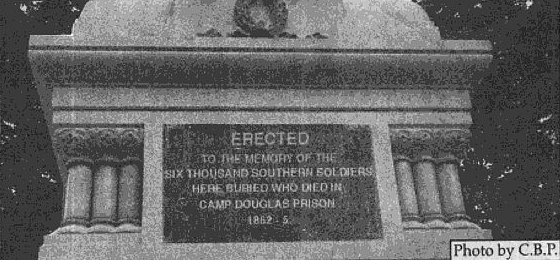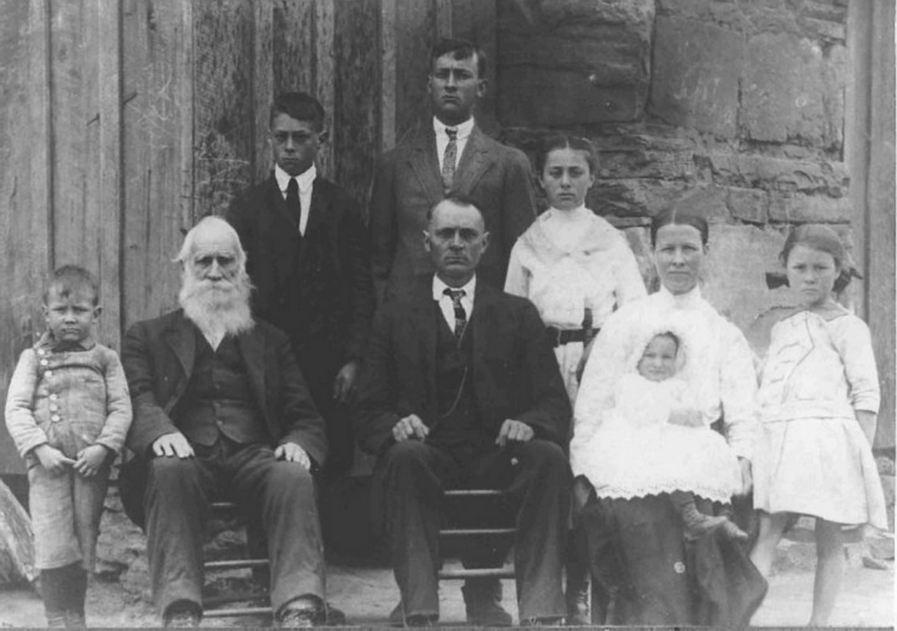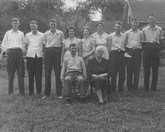|

"TO THE MEMORY OF
THE
SIX THOUSAND SOUTHERN SOLDIERS
HERE BURIED WHO DIED IN
CAMP DOUGLAS PRISON
1862-1865"
View the
Roster
* *
*
Researched and edited
by C. B.
Pritchett
The South had
Andersonville, an internationally known
reminder of prison camp hardships and
deaths, immortalized in song, literature,
film and by many Union Monuments. The
North had Camp Douglas, a little known
civil war prison in Chicago that set
records for prison mortality, hidden in
lost and incomplete records and
suppressed publicity. To the victor
belongs the
silence.
Andersonville is the
National Prisoner of War Historical Site,
with white headstones for each of the 12,
912 Union prisoners who died there with a
475 acre park and monuments erected by
every Union State and the National
Government. All of the main highways of
South Georgia have directional signs to
aid the tens of thousand who visit there
yearly.
Look North to Chicago
and you will find at least 6000
Confederate soldiers buried in a mass
grave on one acre of land. There is only
one monument to these prisoners who died,
erected in 1895, 30 years after the war,
by Southerners and their friends in
Chicago and the
North.
According to Dorothy
Wells Earlandson, writing in Chicago's
Heritage Guest, "few native Chicagoan's
knew of its existence, you see, Chicago
has never publicized its one time camp"
There are no highway directional signs.
We will never see a film about Camp
Douglas or any of the other notorious
Northern prisons. The winners write the
history books, and for 130 years they
have been silent about their prison
camps.
The
Oak Wood Cemetery monument, erected "TO THE
MEMORY OF THE SIX THOUSAND SOUTHERN SOLDIERS
HERE BURIED . . . WHO DIED IN CAMP DOUGLAS
PRISON . . . 1862-65" sustains interest in the
camp located near the shore of Lake Michigan.
Before the camp closed, it has earned the
dubious distinctions of Aundisputed first place
in mortality among Northern
prisons.
Prisoners from Fort
Donelson arrived at Camp Douglas in
February, 1862, and within one year the
monthly mortality rate was at ten
percent, a rate unsurpassed by any other
prison in the North or South. Ultimately,
one in five prisoners died, establishing
the camp's reputation for
"extermination." The highest death rate
at Andersonville was nine percent set for
August, 1864.
Three traits
distinguished Camp Douglas from other
Northern prison camps: high mortality
rates, extreme acts of cruelty, and a low
official count of prisoners who died
compared to documentation from other
sources Historical articles and research
texts have publicized these facts, but
somehow Camp Douglas has escaped the
notoriety of Andersonville. The most
complete treatment of the horrors of Camp
Douglas is contained in George
Levy's To Die in
Chicago (1994) from which some
of the information for this article has
been drawn. Levy was educated at the
University of Chicago and he has served
as Assistant Attorney General for the
state of
Illinois.
The high mortality rate
can be attributed to several factors:
overcrowding, unhealthy living
conditions, ineffective medical
treatment, inadequate food supply, and
brutality. The war lasted longer than
expected, resulting in more prisoners tan
anticipated. By late 1862 there were
8,962 prisoners in the camp with fewer
than 900 guards. Over 200 prisoners were
crowded in to barracks averaging 70 feet
by 25 feet. As the number increased,
tents were erected to house them, with
little protection against below zero
winds. Huge latrines were left open, so
rain washed raw sewage into the drinking
water supply. Wooden floors were removed
to discourage tunneling, so vermin
infected the dirt floors. Rats and mice
were commonplace. Some unnamed inmates
recollecting the camp 37 years later said
that they raised the kitchen floor to
catch "big gray rats" which were made
into rat pies. When cholera and a
smallpox epidemic erupted, free medicine
sent by the South was withheld as
contraband of war. Food rations were
restricted, partly to cut costs and
partly as retaliation for Southern
victories. When control of the camp was
finally passed to the Chicago Police
department, medical supplies were cut off
and food severely
restricted.
On
June 30, 1862, Commandant Colonel Tucker
was warned by D. V. McVickar, the Post
Surgeon that "the surface of the ground
is becoming saturated with the filth and
slop from the privies, kitchens, and
quarters and must produce serious result
to health as soon as the hot weather sets
in." Colonel Tucker was overwhelmed;
there were 326 patients in the hospital
and many more in the
barracks.
Coincidentally, Henry
W. Bellows of the Sanitary Commission
sent a negative report on the camp to
Colonel Hoffman the same day: "Sir, the
amount of standing water, unpoliced
grounds, of foul sinks, of unventilated
and crowded barracks, of general
disorder, of soil reeking miasmatic
accretions, of rotten bones and emptying
of camp kettles, is enough to drive a
sanitarium to despair. I hope that no
thought will be entertained of mending
matters.
The absolute
abandonment of the spot seems to be the
only judicious course, I do not believe
that any amount of drainage would purge
that soil loaded with accumulated filth
or those barr4acks fetid with two stories
of vermin and animal exhalations. Nothin
but fire can cleanse them." The Chicago
Tribune wrote on September 22, 1862, "It
is no wonder they died so rapidly. It is
only a wonder that the whole
eight-thousand of the filthy hogs did not
go home in pine boxes instead of on their
feet."
Civilian doctors, who
inspected Camp Douglas on April 5, 1863, called
it an extermination camp. They drew an
unrelenting picture of "wretched inmates
without change of clothing, covered, with
vermin, in wards reeking with filth and foul
air, and blankets in rags . . . it will be seen
that 260 out of 3,800 prisoners had died in
twenty-one days, a rate of mortality which, if
continued would secure their total
extermination in about 320
days."
Prisoners were deprived
of clothing to discourage escapes. Many
wore sacks with head and arm holes cut
out; few had underwear. Blankets to
offset the bitter northern winter were
confiscated from the few that had them.
The weakest froze to death. The Chicago
winter of 1864 was devastating. The loss
of 1,091 lives in only four months was
heavies for any like period in the camp's
history, and equaled the deaths at the
highest rate of Andersonville from
February to May, 1864 (OR Ser-II-Vol. 8,
986-1003). Yet, it is the name of
Andersonville that burns in infamy, while
there exists a northern counterpart of
little shame.
Mortality rates
increased as Colonel Sweet complained on
October 11, 1864, that mortality at the
camp was up to 35% since June. In
November 1864, the death toll was 217;
another 323 died in December, 308 in
January 1864, and 243 in
February.
THE DEADLY
DEADLINE
The Sparrow diary
specifically mentions the dead line at
Camp Douglas. Prisoners were shot for
crossing the line there just as at such
other Federal prisons as Camp Morton,
Indiana; Camp Chase and Johnson's Island
in Ohio; Point Lookout, Maryland; Newport
New, VA; and Fort Delaware for violating
stated bounds, usually to answer the call
of nature. Several Confederate prisoners
were shot or bayoneted to death while in
the very act of relieving
themselves.
The
arctic weather led to additional suffering.
"Another punishment was to make the men pull
down their pants and sit, with nothin under
them, on the snow and frozen ground. I have
know men to be kept sitting until you could see
their prints of some days after in the snow and
ice. When the [guards] got weary of this they
commenced whipping, making the men lay on a
barrel, and using their belts, which had a
leather clasp with a sharp edge, cutting
through the
skin."
A
prisoner swore that when the men who were
being punished this way attempted to sit
on their coattails they were cruelly
kicked in the back by the guards and
forced to sit longer on their bare bones.
Prisoners were forced to stand in the
snow for hours without moving, and guards
checked footprints to see if they had
moved. Those who did received lashes.
Some prisoners who arrived in the bitter
cold weather lost toes, fingers and ears.
One improvised two wooden pegs as
substitutes for feet and hobbled around
surprisingly
well.
The
mildest cruelty took the form of random firing
into the barracks to disturb the prisoners'
sleep, shooting prisoners who moved too slowly,
or hanging them by their feet to encourage them
to take the "oath to the United States." The
more common severe tortures included "reaching
for the grub," bending over without bending the
knees for several hours, causing blood to gush
from the prisoners nose and protruding eyeballs
almost bursting from their sockets with pain,
or being lashed a hundred times with the metal
buckle end of a belt. "Solitary confinement"
meant being squeezed into a ten foot square
room with twenty others, with only a ten-inch
window for
ventilation.
2
A
fearsome animal came to Prison Square on
June 28, 1864. "The Yanks have fixed a
frame near the gate (to Prison Square)
with a scantling piece of timber across
it, edge up, and about four feet from the
ground, which they make our men ride
whenever the men do anything that does
not please them. It is called The Mule.
Men have sat on it till they fainted and
fell off. It is like riding a sharp top
fence."13
The
"mule" could be made more painful by
adding weights. Sometimes the Yanks would
laugh and say, "I will give you a pair of
spurs" which was a bucket of sand tied to
each foot. Other prisoners confirmed that
men had to ride the mule in the worst
winter weather. By 1865 it had grown to
15 feet tall and required a ladder to
mount. There was a mule for the garrison
in White Oak Square, except there it was
called11
the
"horse".
A SERIOUS FLAW IN THE
RECORD OF CAMP DOUGLAS WAS IN COUNTING
(OR MISCOUNTING) THE
DEAD
"From February 1862,
till all the Secesh had left there,
nearly all of the Medical Colleges in the
northwest were supplied with the bodies
stolen from the dead buried at the city
cemetery and the appearance of the graves
gives evidence of the truth of this
statement."2
On June 9, 1862, a
difference between the Chicago Tribune
and Official Records was reported, with
1,480 men unaccounted for according to
the Tribune. One of the reasons was that
some deaths were
unreported.2
On
July, 186 2, commandant Tucker, in taking
command of Camp Douglas, reported, "there
is scarcely a record left at camp and it
will be difficult to ascertain what
prisoners have been at the camp or what
has become of
them."
By March 31, 1863,
mortality was again out of control, and
diseases claimed 706 prisoners. If true,
the toll in two months was only 277 short
of the 1862 record. Suspiciously, there
are not Camp Douglas returns in the
official records for March 1863. The
Tribune appears to have counted the dead
carefully and indicated that the toll
could have been "upwards of
700."14
Unfortunately, record
keeping was atrocious. It seems that in
the period from February, 1862, to April,
1863, about 728 Confederates were
missing. This in not the worst of it. If
700 died in early 1863, as the Tribune
and some historians of the period
believed, the superintendent should have
found 1,636 graves. Various explanations
were put forward for this discrepancy.
The bodies were being washed into the
lake, according to the Tribune, toward
the water one mile south. The cemetery
was also a favorite hunting ground for
grave robbers. Another explanation is
that the dead were dumped into unmarked
grave and soon lost in the swampy
soil.7
By
1864 about 2,235 prisoners had lost their
lives since the prison opened according
to the Official Records. This may be 967
short of the true figure at the time,
based on the Tribune's
figures.
There were 23,637 cases
of sickness in 1864, according to the
study made at the time. This is more than
three times the number shown in official
records for the entire 700 days at Camp
Douglas; August 1863 to August
1865.
Since they were not
reporting to Washington, the number is
sick in the Barracks (Levy), a lack of
reporting deaths would certainly follow.
According to the History of Camp Douglas,
close to 12,000 prisoners had suffered
through the bitter winter of 1862, and
1863 when temperatures fell below zero.
From 1,400 to 1,700 lay dead but only 615
could be counted in the desolate graves
far from camp. Between 700 and 1000 had
disappeared.
On
December 1, 1866, only 1,402 graves (of
the earlier 2,968) could be identified.
Very little care seems to have been taken
in the interment of bodies. General A.
Hoyt warned that close to 2000 bodies
were now unaccounted for. Somehow Camp
Douglas was exterminating the dead as
well as the
living.
THE CONFEDERATE BURIAL
MOUND
Oak Woods Cemetery
could have become the largest Confederate
burial site outside of the South, but
subsequent events made it impossible to
learn the number buried there. The Oak
Woods Cemetery simply buried whatever the
O'Sullivans, (unqualified grave removers)
brought in, and numbered the grave
markers at Oak Woods according to City
Cemetery records. These records cannot be
verified because no Confederate burials
were recorded with the City
Clerk.2
Also
the army failed to supervise, inspect or
validate the removals. History had been
blindfolded, and there is no way of
knowing how many Confederates, or which
ones, are at Oak
Woods.
On
September 1, 1880, General Bingham
reported, "many of the graves are sunken
and many of the corner stakes are
missing. There is evidences that one of
the sections has been used as a roadway.
The ground around these lots has been
raised and improved which gives them the
sunken appearance." The mound area was
later filled in to the level of the rest
of the cemetery.
Other than the modest
obelisk on this mound, completed in 1893
by sympathizers from the South, from
Chicago, and other parts of the North,
there was nothing to distinguish this
burial site. Thirty years later, bronze
tablets were added with a partial list of
the dead. About 100,000 sympathetic
persons, including President Grover
Cleveland, attended the dedication of the
edifice on Memorial Day, 1895. Since that
time, nothing has been done to
memorialize these unfortunate Confederate
prisoners of war, other than a small
gathering of supporters each year on
Memorial Day.
Camp Douglas has to be
the North's best kept secret of the Civil
War (their Andersonville) but a camp that
must be identified with extreme cruelty
and "convenient" record keeping of the
dead.
Researched
by:
C.B. Pritchett
Jr.
P.O. Box
200
Albany, Ga
31702-0200
NOTE:
All of the above information is
originally documented with
footnotes. The footnotes did
not transfer into html code. If you would
like the footnotes, please write me at
the address
above.
* *
*
Back
to
Top
For more information
please visit the following web site
-
Oak Woods Cemetery
- http://graveyards.com/IL/Cook/oakwoods/confederate2.html
|







